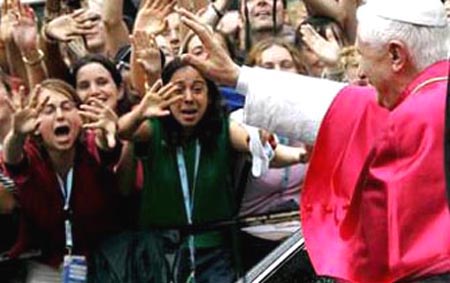 |
Manners, Customs, Clothing
Why Are These Teens Screaming?
Marian T. Horvat, Ph.D.
The three pictures below represent young women in a state of great excitement, I would go so far as to say a kind of hysteria. In the first picture, an early teen screams, although her expression make it uncertain whether it is joy or disappointment that is causing her grimace. In the second picture, the young women also shriek, their arms uplifted to greet some visitor. In the third picture, we face young women experiencing a kind of collective emotional rapture which translates into either smiles or weeping faces. Their hands are uplifted as if they are greeting someone, but we cannot be sure about that since their eyes are closed. Their concentration is turned inward on their own heightened sensations of exhilaration.
The first photo shows a Beatles fan pictured in a complete lack of emotional control. In the second, young shrieking fans in San Francisco become hysterical during the Beatles tour of North America in 1964. This frenzied behavior was termed Beatlemania by concerned commentators of the times. The phenomenon of mass excitement raised by the mere appearance of rock stars has been analyzed by sociologists, who have termed it collective or mass hysteria. It normally begins when an individual makes a hysteric manifestation in front of others who “contagiously” acquire the same symptoms.
Why were parents and Catholic authorities so concerned about this kind of behavior in the 1960s? Because they understood that it violated Catholic temperance that orders the emotions according to right reason. A young Catholic should be formed to act with propriety and decorum. This kind of collective release of passion accustoms a youth to imbibe the spirit of a crowd and lose themselves in unrestrained collective energy, in a kind of pantheistic experience. Beatlemania was the prelude to the Rolling Stones concerts where teens “went berserk” wherever the new high energy rock was being played.
Perhaps you will be surprised to learn that the third picture does not picture fans of some modern day rock star. They are youth greeting the Roman Pontiff at the 2005 World Youth Day in Cologne (see full picture below). You can see that it does not matter for these "fans" whether the “star” is John Paul II or Benedict XVI. This collective hysteria that became a characteristic note of the WYD is much more an expression of unbalanced emotions than of true respect for the Papacy.
What is curious is that today religious authorities encourage youth to engage in the exact behavior that was considered pathological and censurable some 40 years ago.
It seems to me that this is another bad fruit of the adaptation of the Catholic Church to the modern world promoted by Vatican II. Today Church authorities stimulate the youth culture that threw off restraints and fed off sensations. At the World Youth Days, rock concerts are staged to entertain the youth and there is general accommodation to a way of being that gives the passions free dominion, instead of a behavior that conveys a sense of order, proportion and harmony.
It is not just the youth who lose their dignity. Reducing the image of the Pope to a superstar – from the sacral to the vulgar – results not only in a loss of respect for the image of the Papacy, but even its degradation.

Los Angeles Times, August 20, 2005 |

Posted August 31, 2005

Related Topics of Interest
 The Era of the Child The Era of the Child
 Women in Sports Women in Sports
 Secret Spells Barbie and the Tendential Revolution Secret Spells Barbie and the Tendential Revolution
 Courtesy in the Catholic Home Courtesy in the Catholic Home
 Good Ideas Fit with Good Customs Good Ideas Fit with Good Customs
 Appropriate Public Behavior Appropriate Public Behavior

Related Works of Interest
|
|
Manners | Cultural | Home | Books | CDs | Search | Contact Us | Donate

© 2002- Tradition in Action, Inc. All Rights Reserved
|
 |
|